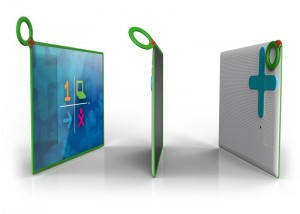The April 2010 issue of Wired Magazine includes an outstanding article by Stephen Levy titled, “Rise of the Machines: How Tablets Will Change The World.” I highly commend it to you. The release of the iPad in a few short weeks is going to be a BIG deal for literacy, communication, and digitally powered learning– not only because it will offer an amazing experience in media consumption, but (according to Levy and other authors contributing to his article collage) because the iPad will herald the tipping point of a new era of literacy. In his accompanying opinion piece, “The End of an Era,” Steven Johnson contends:
It [the extraordinary era of textual innovation] has been an exhilarating ride, but it is coming to an end, and that magical experience of instantly pulling Middlemarch out of the ether and onto your Kindle suggests why: Compared to other kinds of information that computers process today, text has an exceptionally small footprint. With the arrival of the tablet, we have crossed a critical threshold: Where text is concerned, we effectively have infinite computational resources, connectivity, and portability. For decades, futurists have dreamed of the “universal book”: a handheld reading device that would give you instant access to every book in the Library of Congress. In the tablet era, it’s no longer technology holding us back from realizing that vision; it’s the copyright holders.

![]() photo credit: Photos8.com
photo credit: Photos8.com
In this environment of abundant mixed media texts, several things are going to be increasingly essential. One powerful ingredient for learning is being able to create and share multimedia texts online. I offer the digital curriculum for my 15 week “Technology 4 Teachers” course this semester at the University of Central Oklahoma as a case in point. It’s vital to be able to write not only with text, but also with relevant hyperlinks, appropriate images, and embedded media including videos. This is not “just” hyperlinked writing, this is multi-modal communication. The iPad and other tablet technology hardware will make access to multimedia texts like this easier, more common, and eventually “normal.”
A second essential for learning in this touch interface, hyperlinked world of mixed media will be OPEN LICENSING of content. All learners should not only understand the utility of Creative Commons for media remixing, we should also understand its value for content SHARING and repurposing. When students in your class create a media artifact or product to represent what they know and have learned about a specific topic, that media file should be openly licensed so it can become part of the curriculum for my own students next semester or even next week. Mike Linksvayer acknowledged the importance of CC licensing and Open Educational Resources (OER) in his January 2010 post, “CC & OER 2010.” He noted:
… OER may be the single most compelling use of our [Creative Commons] tools, and one that any member of the public can understand right away. Free access to materials for learning, worldwide — of course!
If Steven Johnson is correct, that presently “copyright holders” are blocking the collective “us” from a vision of tablet-accessed, multimedia-rich learning (and I suspect he’s more than partly right) then it’s incumbent upon us (as educators) to redefine our roles as facilitators of student-created content. Our role is not to merely judge and score student work in isolation, hidden from the scrutiny and access of the outside world. Rather, part of our role SHOULD be helping students as well as their parents make wise choices about the sharing and open licensing of their originally created media products. This is a proposition with multiple facets, as Linksvayer noted later in the same post on the CC blog:
… Especially as OER becomes more prevalent in K-12, consideration must be given to the licensing of works created by minors. Our goal is to provide materials which allow parents, teachers, and learners to use and contribute to OER with confidence by following common-sense best practices, keeping parents and teachers involved.
Digital portfolios and multimedia-based assessments of student learning will become increasingly common as more schools implement 1:1 learning programs. This vision of a digital learning future may be harder to see in our current economic times, but make no mistake, it’s coming. In this environment, we need to be thoughtful advocates as well as models for appropriate digital sharing.
I’ll be sharing a presentation at the April 7 Iowa 1:1 Institute (I11I) on “OER: Open Educational Resources – Learn what the open content movement means for 1:1 schools (free digital curriculum.)” As we share our own educational materials with CC licenses and encourage our students/parents to do the same, we do and will make important contributions to the open, digital learning landscape of the 21st century.
Technorati Tags:
creative, edtech, education, ipad, learning, resources, technology, tablet, cc, commons, creativecommons, open, licensing, oer, educational, iowa, i11i
If you enjoyed this post and found it useful, subscribe to Wes’ free newsletter. Check out Wes’ video tutorial library, “Playing with Media.” Information about more ways to learn with Dr. Wesley Fryer are available on wesfryer.com/after.
On this day..
- Tour of New Apple TV (March 2016) – 2016
- Moderate comments on a Posterous Blog – 2011
- iPhone Tethering, Cellular Bandwidth Consumption, & the Home / School Internet Access Divide – 2011
- Help needed with WordPress Header Links CSS – 2010
- Tweet On: Microblogging can help you be more creative – 2010
- No medicine for you, the server is down – 2008
- Read/Write web political disruptions – 2007
- Evolving online security threats deserve more attention – 2007
- Thanks Glen! – 2007
- Digital History – 2007



Comments
One response to “Open licensing of educational media content is KEY”
I love the idea of sharing student-created content on the kind of scale this technology will enable. As a language teacher, international sharing of resources between different cultural and linguistic groups is so exciting.